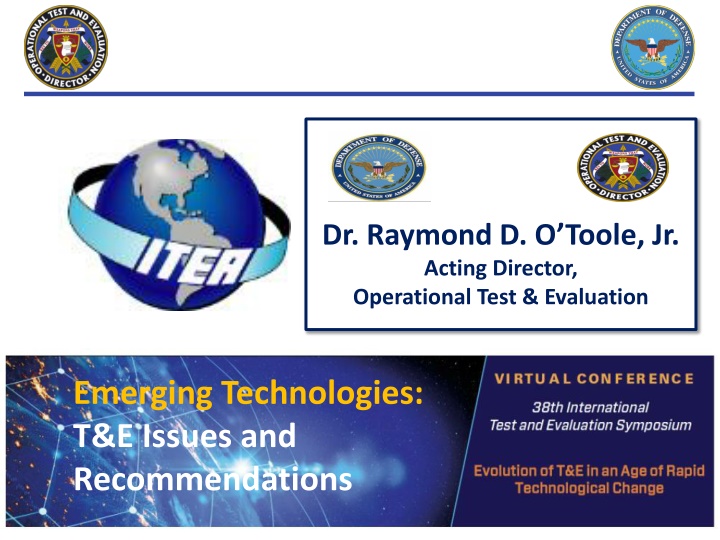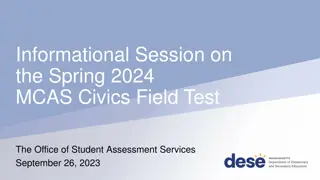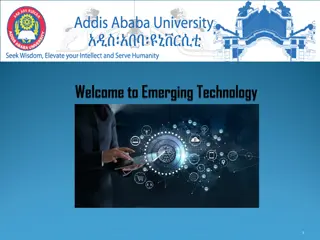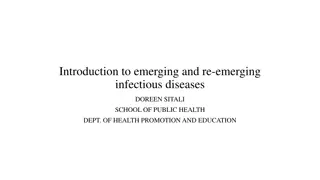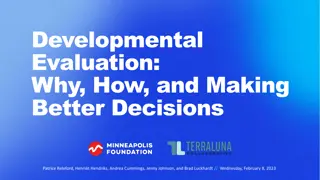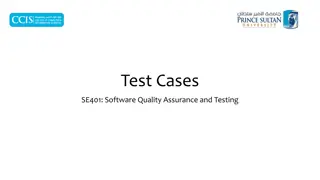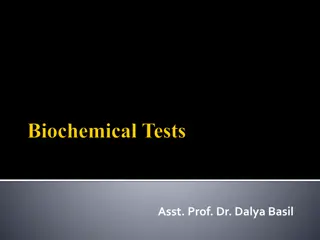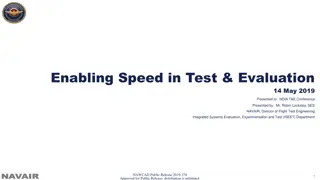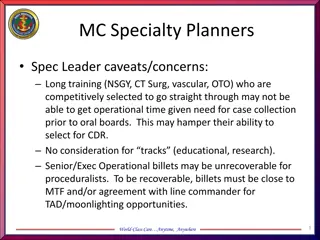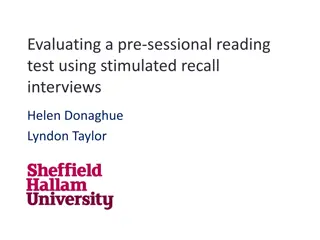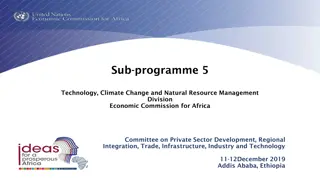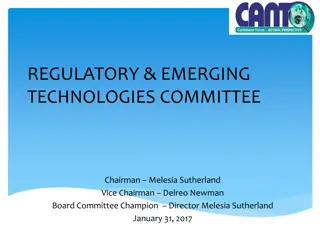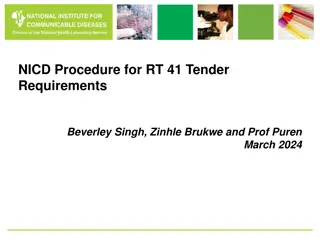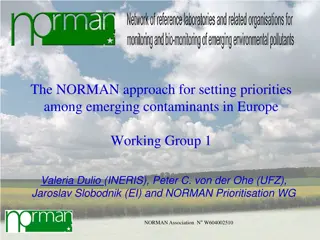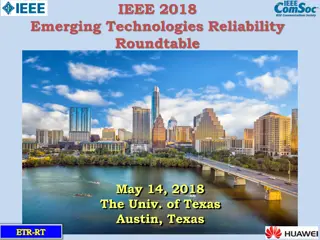Emerging Technologies in Operational Test & Evaluation: Key Insights
Dr. Raymond D. O'Toole, Jr., Acting Director, discusses critical emerging technologies including Software-Enabled Systems, Hypersonics, Directed Energy, Autonomous Systems, and more. Key attributes of Autonomous Systems are highlighted, emphasizing Situated Agency, Adaptive Cognition, Multi-Agent Emergence, and Experiential Learning. T&E concerns and insights from studies by T. Menzies and C. Pecheur are also addressed.
Uploaded on Oct 09, 2024 | 0 Views
Download Presentation

Please find below an Image/Link to download the presentation.
The content on the website is provided AS IS for your information and personal use only. It may not be sold, licensed, or shared on other websites without obtaining consent from the author.If you encounter any issues during the download, it is possible that the publisher has removed the file from their server.
You are allowed to download the files provided on this website for personal or commercial use, subject to the condition that they are used lawfully. All files are the property of their respective owners.
The content on the website is provided AS IS for your information and personal use only. It may not be sold, licensed, or shared on other websites without obtaining consent from the author.
E N D
Presentation Transcript
Dr. Raymond D. OToole, Jr. Acting Director, Operational Test & Evaluation Emerging Technologies: T&E Issues and Recommendations 1
DODs Emerging Technologies 1. Software-Enabled Systems and Cybersecurity 2. Hypersonics 3. Directed Energy 4. Autonomous Systems and Artificial Intelligence 5. Fully Networked Command, Control, and Communications Technology 6. Space 7. Fifth Generation Communications Networks (5G) 8. Biotechnology 9. Microelectronics 10. Quantum Science and Technology 2
DODs Emerging Technologies 1. Software-Enabled Systems and Cybersecurity 2. Hypersonics 3. Directed Energy 4. Autonomous Systems and Artificial Intelligence 5. Fully Networked Command, Control, and Communications Technology 6. Space 7. Fifth Generation Communications Networks (5G) 8. Biotechnology 9. Microelectronics 10. Quantum Science and Technology 3
Key Attributes of Autonomous Systems Situated Agency Sensing the environment, assessing the situation, reasoning about it, making decisions to reach a goal, and then acting on it Adaptive Cognition Using different modes of thinking , from low-level rules, to high-level reasoning Multi-Agent Emergence Interacting with other agents, human or otherwise, affording novel emergent behavior of the group/team Experiential Learning Learning new behaviors over time and experience Desired properties Proficiency, trustworthiness, flexibility Enabled by Artificial Intelligence 4
Key Attributes of Autonomous Systems Situated Agency Sensing the environment, assessing the situation, reasoning about it, making decisions to reach a goal, and then acting on it Adaptive Cognition Using different modes of thinking , from low-level rules, to high-level reasoning Multi-Agent Emergence Interacting with other agents, human or otherwise, affording novel emergent behavior of the group/team Experiential Learning Learning new behaviors over time and experience Desired properties Proficiency, trustworthiness, flexibility Enabled by Artificial Intelligence 5
T&E Concerns: Some Studies T. Menzies and C Pecheur, Verification and Validation and Artificial Intelligence, Preprint submitted to Elsevier Science, 12 July 2004 W. Dahm, 2011. Technology Horizons: A Vision for Air Force Science and Technology 2010-30. Maxwell AFB, AL: Air University Press. V. Roske, I. Kohlberg, and R. Wagner, Autonomous Systems Challenges to Test and Evaluation, National Defense Industrial Association, Test and Evaluation Conference, 12-15 March 2012 DSB, 2012 Defense Science Board Autonomy Study: Office of the Under Secretary of Defense for Acquisition, Technology and Logistics, The Role of Autonomy in DoD Systems, Washington, DC, 2012 DOD, DOD R&E Autonomy Community of Interest, T&E V&V (TEVV) Working Group, Technology Investment Strategy 2015-2018, OASD(R&E), May 2015 D. Ahner and C. Parson, Workshop Report: Test and Evaluation of Autonomous Systems, STAT Center of Excellence, Wright-Patterson AFB, OH, 2016 DSB, 2016 Defense Science Board Autonomy Study: Office of the Under Secretary of Defense for Acquisition, Technology and Logistics, Report of the Defense Science Board Summer Study on Autonomy, Washington DC, 2016 A. Hill and G. Thompson, FIVE GIANT LEAPS FOR ROBOTKIND: EXPANDING THE POSSIBLE IN AUTONOMOUS WEAPONS, War on the Rocks, https://warontherocks.com/2016/12/five-giant-leaps-for-robotkind-expanding-the-possible-in-autonomous-weapons/, 28 DEC 2016 SAB, US Air Force Scientific Advisory Board, Adapting Air Force Test and Evaluation to Emerging System Needs, SAB-TR-17-03, 15 September 2017 B. Haugh, D. Sparrow, and D. Tate, The Status of Test, Evaluation, Verification, and Validation (TEV&V) of Autonomous Systems, P- 9292, Institute for Defense Analysis, Alexandria, VA, 2018 T. Talafuse and D. Ahner, Workshop Report: Test and Evaluation of Autonomous Systems, Scientific Test and Analysis Techniques (STAT) Center of Excellence (COE), Air Force Institute of Technology, March 2018 D. K. Ahner, C. R. Parson, J. L. Thompson, and W. F. Rowell, Overcoming the Challenges in Test and Evaluation of Autonomous Robotic Systems, ITEA J. of Test and Evaluation, 39: 86-94, June 2018 A. L. McLean, J. R. Bertram, J. A. Hoke, S. S. Rediger, and J. C. Skarphol, LVC-Enabled Testbed for Autonomous System Testing, ITEA J. of Test and Evaluation, 39: 120-128, June 2018 P. Caseley, Human-Machine Trust: Risk-Based Assurance and Licensing of Autonomous Systems, SCI-313 Specialist Meeting Report, NATO STO-MP-SCI-313, 3-5 December 2018 H. Miller, Senate Report on Test Infrastructure: Autonomy, MITRE, April 2019 [need updated version] J.C. Lede, Autonomy Overview, US-Japan Service to Service Dialog, Autonomy Community of Interest Lead, AFRL, OSD, 5 APR 2019 Y. Gil and B. Selman, A 20-Year Community Roadmap for Artificial Intelligence Research in the US, American Association for Artificial Intelligence Draft Report, May 2019 6
T&E Concerns: Some Studies T. Menzies and C Pecheur, Verification and Validation and Artificial Intelligence, Preprint submitted to Elsevier Science, 12 July 2004 W. Dahm, 2011. Technology Horizons: A Vision for Air Force Science and Technology 2010-30. Maxwell AFB, AL: Air University Press. V. Roske, I. Kohlberg, and R. Wagner, Autonomous Systems Challenges to Test and Evaluation, National Defense Industrial Association, Test and Evaluation Conference, 12-15 March 2012 DSB, 2012 Defense Science Board Autonomy Study: Office of the Under Secretary of Defense for Acquisition, Technology and Logistics, The Role of Autonomy in DoD Systems, Washington, DC, 2012 DOD, DOD R&E Autonomy Community of Interest, T&E V&V (TEVV) Working Group, Technology Investment Strategy 2015-2018, OASD(R&E), May 2015 D. Ahner and C. Parson, Workshop Report: Test and Evaluation of Autonomous Systems, STAT Center of Excellence, Wright-Patterson AFB, OH, 2016 DSB, 2016 Defense Science Board Autonomy Study: Office of the Under Secretary of Defense for Acquisition, Technology and Logistics, Report of the Defense Science Board Summer Study on Autonomy, Washington DC, 2016 A. Hill and G. Thompson, FIVE GIANT LEAPS FOR ROBOTKIND: EXPANDING THE POSSIBLE IN AUTONOMOUS WEAPONS, War on the Rocks, https://warontherocks.com/2016/12/five-giant-leaps-for-robotkind-expanding-the-possible-in-autonomous-weapons/, 28 DEC 2016 SAB, US Air Force Scientific Advisory Board, Adapting Air Force Test and Evaluation to Emerging System Needs, SAB-TR-17-03, 15 September 2017 B. Haugh, D. Sparrow, and D. Tate, The Status of Test, Evaluation, Verification, and Validation (TEV&V) of Autonomous Systems, P- 9292, Institute for Defense Analysis, Alexandria, VA, 2018 T. Talafuse and D. Ahner, Workshop Report: Test and Evaluation of Autonomous Systems, Scientific Test and Analysis Techniques (STAT) Center of Excellence (COE), Air Force Institute of Technology, March 2018 D. K. Ahner, C. R. Parson, J. L. Thompson, and W. F. Rowell, Overcoming the Challenges in Test and Evaluation of Autonomous Robotic Systems, ITEA J. of Test and Evaluation, 39: 86-94, June 2018 A. L. McLean, J. R. Bertram, J. A. Hoke, S. S. Rediger, and J. C. Skarphol, LVC-Enabled Testbed for Autonomous System Testing, ITEA J. of Test and Evaluation, 39: 120-128, June 2018 P. Caseley, Human-Machine Trust: Risk-Based Assurance and Licensing of Autonomous Systems, SCI-313 Specialist Meeting Report, NATO STO-MP-SCI-313, 3-5 December 2018 H. Miller, Senate Report on Test Infrastructure: Autonomy, MITRE, April 2019 [need updated version] J.C. Lede, Autonomy Overview, US-Japan Service to Service Dialog, Autonomy Community of Interest Lead, AFRL, OSD, 5 APR 2019 Y. Gil and B. Selman, A 20-Year Community Roadmap for Artificial Intelligence Research in the US, American Association for Artificial Intelligence Draft Report, May 2019 And more are on the way (!) 7
Autonomous Systems: T&E Issues Flexible ASs operating in complex, dynamic, stochastic environments External variability + internal complexities Learning over time and experience can change behaviors Emergence of behaviors across agents huge non-convex state spaces non-stationarity potential for changing CONOPS Infrastructure shortcomings Difficulty specifying requirements at an operational/behavioral level Acquisition pipeline fundamentally materiel-oriented Lack of common AS architectures/frameworks Lack of T&E methods, tools, testbeds, ranges, and experienced personnel No up-front instrumentation or design for testability or explainability Current certification methods predominantly manual, subjective, specialized Unique T&E challenges ensuring safety and security Real-time monitoring systems for safe operations bring own T&E demands Conventional cyber attacks can be tuned for subtle attacks on performance And adversarial attacks call for expanded T&E scope to better model threats 8 AS: Autonomous System; CONOPS: Concept of Operations
Autonomous Systems: T&E Recommendations T&E needs to influence requirements, design, and development Architect ASs using common frameworks and modular subsystems Support cognitive instrumentation via sensors, assessors, and explainers Curate training data and follow accepted HSI design principles Extend/develop T&E methods/tools to deal with stochastic, adaptive, emergent behaviors, and AS-specific vulnerabilities Methods/tools for complex, non-stationary, and non-deterministic systems Account for emergent behavior and defining the SUT New statistical engineering methods for T&E design and analysis Assessment/mitigation of subtle cyberattacks and adversarial attack vectors Invest in infrastructure and process Develop unifying infrastructure for requirements generation/traceability Move to T&E Lifecycle viewpoint and Invest in digital modernization Make massive use of M&S, test automation, & data analytics everywhere Human-System teaming View the H-S Team as the SUT and embrace co-development of CONOPS with ASs 9 AS: Autonomous System; SUT: System Under Test; M&S: Modeling and Simulation
Autonomous Systems: T&E Recommendations T&E needs to influence requirements, design, and development Architect ASs using common frameworks and modular subsystems Support cognitive instrumentation via sensors, assessors, and explainers Curate training data and follow accepted HSI design principles Extend/develop T&E methods/tools to deal with stochastic, adaptive, emergent behaviors, and AS-specific vulnerabilities Methods/tools for complex, non-stationary, and non-deterministic systems Account for emergent behavior and defining the SUT New statistical engineering methods for T&E design and analysis Assessment/mitigation of subtle cyberattacks and adversarial attack vectors Invest in infrastructure and process Develop unifying infrastructure for requirements generation/traceability Move to T&E Lifecycle viewpoint and Invest in digital modernization Make massive use of M&S, test automation, & data analytics everywhere Human-System teaming View the H-S Team as the SUT and embrace co-development of CONOPS with ASs 10 AS: Autonomous System; SUT: System Under Test; M&S: Modeling and Simulation
Framework for Human- Autonomy Teaming This framework: Gives specific direction on teaming factors Enables tests of whether a team is effective in general, not just during the observed task 11 Image Credits: 1. Are Drones Changing the Way We Live?, D!gitalist, Nov. 2019, https://www.digitalistmag.com/digital-economy/2019/11/05/are-drones-changing-way-we-live- 06201367/
Dr. Raymond D. OToole, Jr. Acting Director, Operational Test & Evaluation 12
Backups 13
Next Steps for DOT&E Short term Instances of partial autonomy at the component level in test plans are now coming through the office Working to develop interim guidelines for dealing with these Mid term This trend will accelerate Working with multiple AI/AS T&E groups throughout DOD covering policy, guidance, technologies, testbeds, and workforce Reaching out to all of you in how to deal with this nascent technology Need to execute smartly on the recommendations to get ahead of the expected T&E challenges 14
